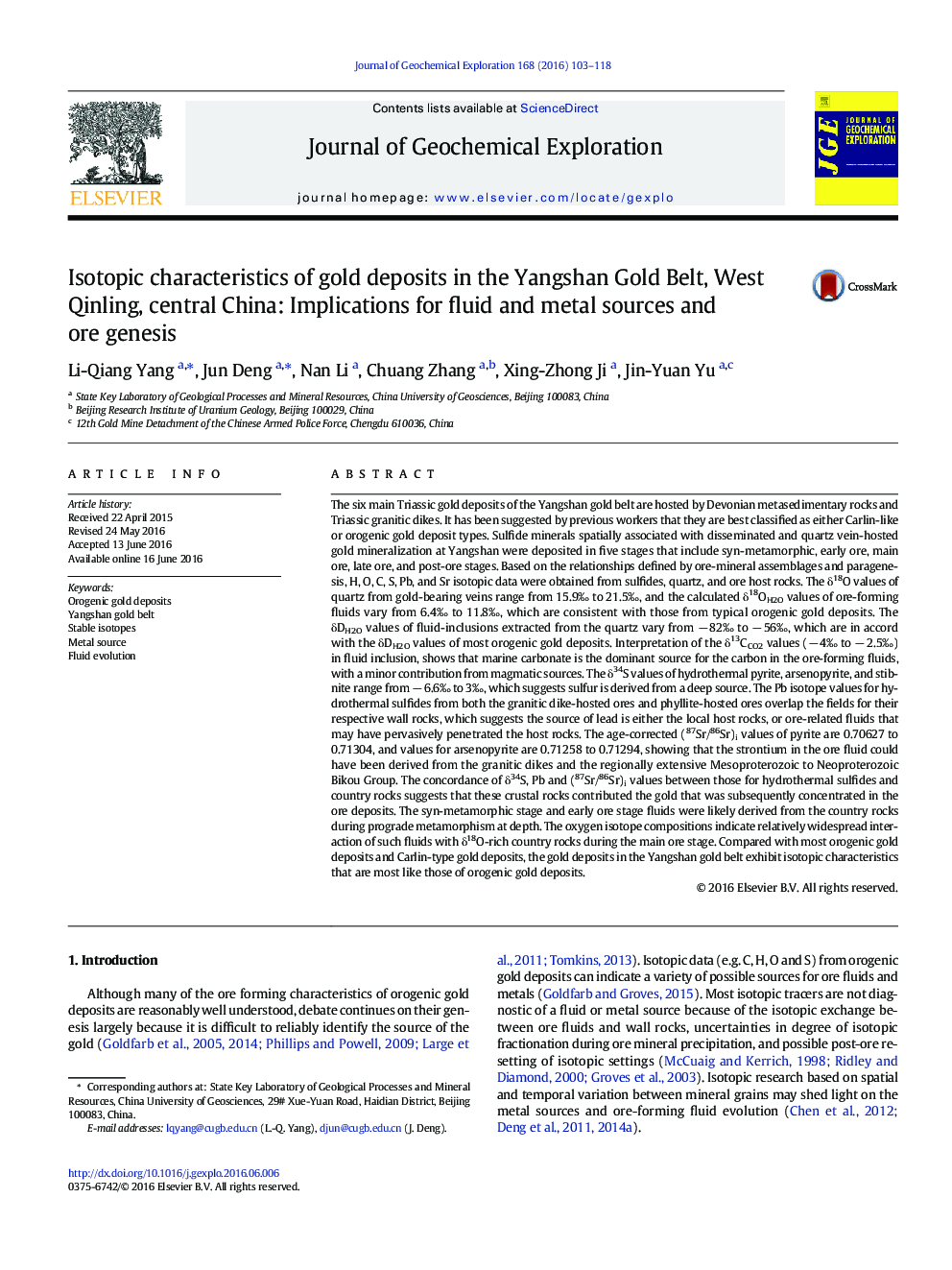| کد مقاله | کد نشریه | سال انتشار | مقاله انگلیسی | نسخه تمام متن |
|---|---|---|---|---|
| 4456945 | 1620891 | 2016 | 16 صفحه PDF | دانلود رایگان |
• C–H–O–S–Sr isotopes show granitic dikes, Bikou & Sanhekou Group offer ore-forming material.
• Isotope data shows the ore fluids originated from metamorphic water.
• Yangshan gold deposits are orogenic type for geology and isotopic geochemistry.
The six main Triassic gold deposits of the Yangshan gold belt are hosted by Devonian metasedimentary rocks and Triassic granitic dikes. It has been suggested by previous workers that they are best classified as either Carlin-like or orogenic gold deposit types. Sulfide minerals spatially associated with disseminated and quartz vein-hosted gold mineralization at Yangshan were deposited in five stages that include syn-metamorphic, early ore, main ore, late ore, and post-ore stages. Based on the relationships defined by ore-mineral assemblages and paragenesis, H, O, C, S, Pb, and Sr isotopic data were obtained from sulfides, quartz, and ore host rocks. The δ18O values of quartz from gold-bearing veins range from 15.9‰ to 21.5‰, and the calculated δ18OH2O values of ore-forming fluids vary from 6.4‰ to 11.8‰, which are consistent with those from typical orogenic gold deposits. The δDH2O values of fluid-inclusions extracted from the quartz vary from − 82‰ to − 56‰, which are in accord with the δDH2O values of most orogenic gold deposits. Interpretation of the δ13CCO2 values (− 4‰ to − 2.5‰) in fluid inclusion, shows that marine carbonate is the dominant source for the carbon in the ore-forming fluids, with a minor contribution from magmatic sources. The δ34S values of hydrothermal pyrite, arsenopyrite, and stibnite range from − 6.6‰ to 3‰, which suggests sulfur is derived from a deep source. The Pb isotope values for hydrothermal sulfides from both the granitic dike-hosted ores and phyllite-hosted ores overlap the fields for their respective wall rocks, which suggests the source of lead is either the local host rocks, or ore-related fluids that may have pervasively penetrated the host rocks. The age-corrected (87Sr/86Sr)i values of pyrite are 0.70627 to 0.71304, and values for arsenopyrite are 0.71258 to 0.71294, showing that the strontium in the ore fluid could have been derived from the granitic dikes and the regionally extensive Mesoproterozoic to Neoproterozoic Bikou Group. The concordance of δ34S, Pb and (87Sr/86Sr)i values between those for hydrothermal sulfides and country rocks suggests that these crustal rocks contributed the gold that was subsequently concentrated in the ore deposits. The syn-metamorphic stage and early ore stage fluids were likely derived from the country rocks during prograde metamorphism at depth. The oxygen isotope compositions indicate relatively widespread interaction of such fluids with δ18O-rich country rocks during the main ore stage. Compared with most orogenic gold deposits and Carlin-type gold deposits, the gold deposits in the Yangshan gold belt exhibit isotopic characteristics that are most like those of orogenic gold deposits.
Figure optionsDownload as PowerPoint slide
Journal: Journal of Geochemical Exploration - Volume 168, September 2016, Pages 103–118
